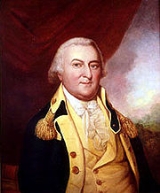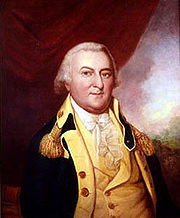
John Hoskins Stone
Encyclopedia

United States
The United States of America is a federal constitutional republic comprising fifty states and a federal district...
planter, soldier, and politician from Charles County, Maryland
Charles County, Maryland
Charles County is a county in the south central portion of the U.S. state of Maryland.As of 2010, the population was 146,551. Its county seat is La Plata. This county was named for Charles Calvert , third Baron Baltimore....
. During the Revolutionary War
American Revolutionary War
The American Revolutionary War , the American War of Independence, or simply the Revolutionary War, began as a war between the Kingdom of Great Britain and thirteen British colonies in North America, and ended in a global war between several European great powers.The war was the result of the...
he led the 1st Maryland Regiment of the Continental Army
Continental Army
The Continental Army was formed after the outbreak of the American Revolutionary War by the colonies that became the United States of America. Established by a resolution of the Continental Congress on June 14, 1775, it was created to coordinate the military efforts of the Thirteen Colonies in...
. After the war he served in the state legislature and was the seventh Governor from 1794 to 1797.
Personal life
John was born at his father's plantation of Poynton Manor in Charles County. His family had been prominent since early colonial days when William Stone had served as governor a hundred years before his birth. His parents were David and Elizabeth (Jenifer) Stone. His elder brothers included ThomasThomas Stone
Thomas Stone was an American planter who signed the United States Declaration of Independence as a delegate for Maryland. He later worked on the committee that formed the Articles of Confederation in 1777...
(who signed the Declaration of Independence
United States Declaration of Independence
The Declaration of Independence was a statement adopted by the Continental Congress on July 4, 1776, which announced that the thirteen American colonies then at war with Great Britain regarded themselves as independent states, and no longer a part of the British Empire. John Adams put forth a...
) and Michael
Michael J. Stone
Michael Jenifer Stone was an American planter and statesman from Charles County, Maryland. He represented Maryland in the U.S. House.Michael was born to David and Elizabeth Stone at Poynton Manor in Charles County...
(who represented Maryland in the U.S. Congress
United States House of Representatives
The United States House of Representatives is one of the two Houses of the United States Congress, the bicameral legislature which also includes the Senate.The composition and powers of the House are established in Article One of the Constitution...
).
John had been baptized in the Anglican Church
Church of England
The Church of England is the officially established Christian church in England and the Mother Church of the worldwide Anglican Communion. The church considers itself within the tradition of Western Christianity and dates its formal establishment principally to the mission to England by St...
. After the split caused by the reviolution he was an active Episcopalean. He married Anne Couden in February 1781, and the couple would have six children, five of whom lived to adulthood: Couden, Anne, Elizabeth, Robert Couden, and Thomas.
Revolutionary war
In 1775, Stone joined the newly organized Maryland Battalion led by Colonel William SmallwoodWilliam Smallwood
William Smallwood was an American planter, soldier and politician from Charles County, Maryland. He served in the American Revolutionary War, rising to the rank of major general...
as a Lieutenant. He was soon promoted to Captain of the battalion's first company. The battalion became part of the 1st Maryland Regiment
1st Maryland Regiment
The 1st Maryland Regiment originated with the authorization of a Maryland Battalion of the Maryland State Troops on 14 January 1776...
of the Continental Army
Continental Army
The Continental Army was formed after the outbreak of the American Revolutionary War by the colonies that became the United States of America. Established by a resolution of the Continental Congress on June 14, 1775, it was created to coordinate the military efforts of the Thirteen Colonies in...
, and went north to fight in the war. They fought in the Battles of Brooklyn
Battle of Long Island
The Battle of Long Island, also known as the Battle of Brooklyn or the Battle of Brooklyn Heights, fought on August 27, 1776, was the first major battle in the American Revolutionary War following the United States Declaration of Independence, the largest battle of the entire conflict, and the...
(where Captain Stone was especially distinguished) and White Plains
Battle of White Plains
The Battle of White Plains was a battle in the New York and New Jersey campaign of the American Revolutionary War fought on October 28, 1776, near White Plains, New York. Following the retreat of George Washington's Continental Army northward from New York City, British General William Howe landed...
. Then, in late 1776, when Smallwood was promoted to Brigadier General, Stone became the Lieutenant Colonel of the regiment.
When the Continental Line was re-organized early in 1777, General Smallwood had earned additional responsibility as a brigade commander. Stone was made Colonel and commander of the 1st Maryland. He led the regiment in the Battles of Princeton
Battle of Princeton
The Battle of Princeton was a battle in which General George Washington's revolutionary forces defeated British forces near Princeton, New Jersey....
, Brandywine
Battle of Brandywine
The Battle of Brandywine, also known as the Battle of the Brandywine or the Battle of Brandywine Creek, was fought between the American army of Major General George Washington and the British-Hessian army of General Sir William Howe on September 11, 1777. The British defeated the Americans and...
, and Germantown
Battle of Germantown
The Battle of Germantown, a battle in the Philadelphia campaign of the American Revolutionary War, was fought on October 4, 1777, at Germantown, Pennsylvania between the British army led by Sir William Howe and the American army under George Washington...
. He was wounded at Germantown and as a result was lame for the rest of his life.
Colonel Stone was back in active command by the Battle of Monmouth
Battle of Monmouth
The Battle of Monmouth was an American Revolutionary War battle fought on June 28, 1778 in Monmouth County, New Jersey. The Continental Army under General George Washington attacked the rear of the British Army column commanded by Lieutenant General Sir Henry Clinton as they left Monmouth Court...
. His unit was active in the continuing defense of New Jersey
New Jersey
New Jersey is a state in the Northeastern and Middle Atlantic regions of the United States. , its population was 8,791,894. It is bordered on the north and east by the state of New York, on the southeast and south by the Atlantic Ocean, on the west by Pennsylvania and on the southwest by Delaware...
. His career ended when he was wounded again in the Battle of Stony Point
Battle of Stony Point
The Battle of Stony Point was a battle of the American Revolutionary War fought on the night of July 15–16, 1779. A select force of Continental Army infantry made a coordinated surprise night attack and stormed a fortified position of the British Army on the Hudson River south of West Point, New...
on July 14, 1779. This time his wounds were more serious and he resigned his commission on August 1.
Political career
Stone returned home to Maryland and was made a member of the state's Executive Council. He served there from 1779 until 1785. Charles County elected him to the Maryland House of DelegatesMaryland House of Delegates
The Maryland House of Delegates is the lower house of the General Assembly, the state legislature of the U.S. state of Maryland, and is composed of 141 Delegates elected from 47 districts. The House chamber is located in the state capitol building on State Circle in Annapolis...
in 1785. He was returned annually until 1787, and again in 1790. Stone was then returned to the state Council in 1791 and 1792.
John was elected to a single three year term as Governor of Maryland, and served from 1794 to 1797 before returning to private life. He died in 1804 at Annapolis, Maryland
Annapolis, Maryland
Annapolis is the capital of the U.S. state of Maryland, as well as the county seat of Anne Arundel County. It had a population of 38,394 at the 2010 census and is situated on the Chesapeake Bay at the mouth of the Severn River, south of Baltimore and about east of Washington, D.C. Annapolis is...
and was buried there.

